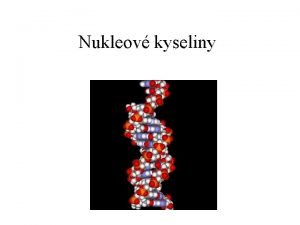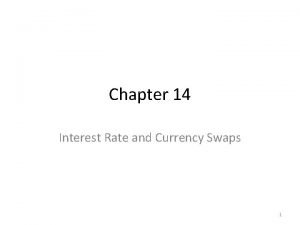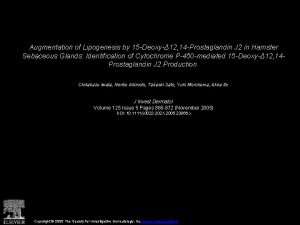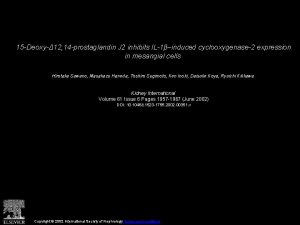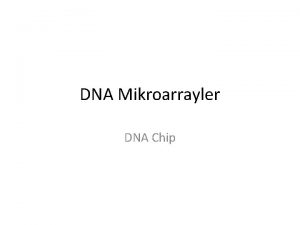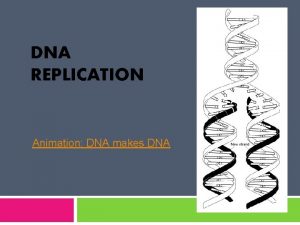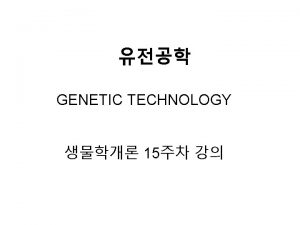Deoxy WHAT Unwinding the mystery of DNA Standard
















- Slides: 16

Deoxy- WHAT? ? ? Unwinding the mystery of DNA Standard B 4. 1 -4. 3 - The student will compare DNA and RNA in terms of structure, nucleotides and base pairs; they will be able to summarize the relationship amond DNA, Genes and chromosomes; and explain how DNA functions as the code of life.

Deoxyribonucleic Acid § What exactly is DNA? – Long molecule of nucleotides – Carries genetic information from one generation to the next – Puts information to work by determining heritable traits – Is easily copied

What are nucleic acids? § Nucleic Acids are organic molecules that serve as the blue print for proteins. § Through the action of proteins- nucleic acids are the basis of all cellular activity § 2 types of nucleic acids: – DNA- deoxyribonucleic acid – RNA- ribonucleic acid – Both are composed of small units called nucleotides.

Nucleotides § Each nucleotide is made up of three parts: – – – A simple 5 - Carbon sugar= deoxyribose A Phosphate group A nitrogenous base: Cytosine (C), Guanine (G) Adenine (A), Thymine (T)(DNA only) Uracil (U) (RNA only) 4 different possible bases and 2 groups – Purines and Pyrimidines – Purines = adenine and guanine – Pyrimidines = cytosine and thymine

Discovery of ‘Double Helix’ § Prior to discovery of shape of DNA, scientists thought DNA was merely a ‘string of nucleotides’. § The work of many different scientists led to the discovery by Watson and Crick. – Avery – Franklin – Hershey and Chase – Griffith

DNA-The Double Helix § Two single strands of nucleotides wound around each other that are chemically bonded through the axis of the helix § Resembles a twisted ladder or spiral staircase. § Held together by hydrogen bonds that ONLY form between certain base pairs. – Guanine and Cytosine – Adenine and Thymine

RNA: § -A single chain of nucleotides with nitrogenous bases exposed along the side § -When RNA bonds to a strand of DNA- each RNA base can only bond with one type of DNA. § -This is called complementary base pairing § -Guanine-Cytosine § -Uracil- Adenine

Base Pairing Rule § Chargraff’s Rules: § DNA: RNA: – A=T A=U – G=C Bacteria and Humans both obey this ruledespite structural differences.

RNA versus DNA § 3 Main Differences: -Single Strand versus double strand -Sugar is Ribose versus Deoxyribose -Contains Uracil in place of Thymine

Types of RNA § 3 Main types of RNA – Messenger RNA = m. RNA – Ribosomal RNA = r. RNA – Transfer RNA = t. RNA

RNA’s Job § RNA’s Main job is protein synthesis – Messenger RNA carries the instructions from DNA to the rest of the cell. – Proteins are assembled on the ribosomes. Ribosomal RNA – Transfer RNA transfers each amino acid to the ribosome by its specified m. RNA codon.

Relationship of Chromosomes, DNA, and genes Chromosomes are structures in the nucleus of a cell consisting essentially of one long thread of DNA that is tightly coiled. DNA- composed of nucleotides- is the blueprint for the synthesis of proteins by the arrangement of nitrogenous bases. ** the code for a particular amino acid is determined by the sequence of 3 base pairs on the DNA

Continued: § A Gene is a specific location on a chromosome, consisting of a segment of DNA, that codes for a particular protein – The particular proteins coded by the DNA on the genes determine the characteristics of an organism – Each chromosome consists of hundreds of genes determining the many proteins for an individual organism

DNA as the ‘code of life’ § Considered the code of life or blueprint because it contains the code for each protein that the organism needs. § The specific protein is determined by the order of nitrogenous bases § Each cell in an organisms body contains a complete set of chromosomes

Continued: § Number of chromosomes varies with type of organism. Example- humans = 23 pairs, dogs = 39 pairs, potatoes = 24 pairs § 23 rd pair determines sex (sex chromosomes), other 22 pairs= autosomal § Every cell contains one pair of the autosomal chromosomes (one from Mom and one from dad) § Each chromosome consists of thousands of genes § The closer you are related, the more similar your genes.

To be continued…. . § The end
 Cytosin
Cytosin Unwinding swaps
Unwinding swaps Bioflix activity dna replication dna replication diagram
Bioflix activity dna replication dna replication diagram Coding dna and non coding dna
Coding dna and non coding dna What role does dna polymerase play in copying dna?
What role does dna polymerase play in copying dna? Replication
Replication Dna and genes chapter 11
Dna and genes chapter 11 Tỉ lệ cơ thể trẻ em
Tỉ lệ cơ thể trẻ em Fecboak
Fecboak đặc điểm cơ thể của người tối cổ
đặc điểm cơ thể của người tối cổ Các châu lục và đại dương trên thế giới
Các châu lục và đại dương trên thế giới Thế nào là hệ số cao nhất
Thế nào là hệ số cao nhất Sơ đồ cơ thể người
Sơ đồ cơ thể người ưu thế lai là gì
ưu thế lai là gì Các môn thể thao bắt đầu bằng tiếng chạy
Các môn thể thao bắt đầu bằng tiếng chạy Tư thế ngồi viết
Tư thế ngồi viết Cái miệng xinh xinh thế chỉ nói điều hay thôi
Cái miệng xinh xinh thế chỉ nói điều hay thôi
